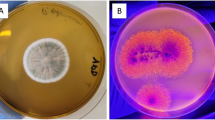Abstract
The aim of this present study was to produce a microbial enzyme that can potentially be utilized for the enzymatic transesterification of waste cooking oil. To that end, an extracellular lipase was isolated and purified from the culture broth of Streptomyces sp. CS273. The molecular mass of purified lipase was estimated to be 36.55 kDa by SDS PAGE. The optimum lipolytic activity was obtained at alkaline pH 8.0 to 8.5 and temperature 40 °C, while the enzyme was stable in the pH range 7.0 ∼ 9.0 and at temperature ≤40 °C. The lipase showed highest hydrolytic activity towards p-nitrophenyl myristate (C14). The lipase activity was enhanced by several salts and detergents including NaCl, MnSo4, and deoxy cholic acid, while phenylmethylsulfonyl fluoride at concentration 10 mM inhibited the activity. The lipase showed tolerance towards different organic solvents including ethanol and methanol which are commonly used in transesterification reactions to displace alcohol from triglycerides (ester) contained in renewable resources to yield fatty acid alkyl esters known as biodiesel. Applicability of the lipase in transesterification of waste cooking oil was confirmed by gas chromatography mass spectrometry analysis.




Similar content being viewed by others
References
Zhang, Y., Dube, M., McLean, D., & Kates, M. (2003). Bioresource Technology, 89(1), 1–16.
Szczęsna, A. M., Kubiak, A., Antczak, T., & Bielecki, S. (2009). Renewable Energy, 34(5), 1185–1194.
Wang, Y., Liu, P., Ou, S., & Zhang, Z. (2007). Energy Conversion and Management, 48(1), 184–188.
Ghaly, A. E., Dave, D., Brooks, M., & Budge, S. (2010). American Journal of Biochemistry and Biotechnology, 6(2), 54–76.
Gang, W., Guang, C., & Ming, W. (2011). African Journal of Biotechnology, 10(61), 13174–13179.
Whangsuk, W., Sungkeeree, P., Thiengmag, S., Kerdwong, J., Sallabhan, R., Mongkolsuk, S., et al. (2013). Molecular Biotechnology, 53(1), 55–62.
Ji, Q., Xiao, S., He, B., & Liu, X. (2010). Journal of Molecular Catalysis B: Enzymatic, 66(3), 264–269.
Mander, P., Cho, S. S., Simkhada, J. R., Choi, Y. H., Ha, J. W., & Yoo, J. C. (2012). Biotechnology and Bioprocess Engineering, 17(1), 67–75.
Mander, P., Cho, S. S., Simkhada, J. R., Choi, Y. H., Park, D. J., & Yoo, J. C. (2012). Process Biochemistry, 47(4), 635–642.
Bradford, M. M. (1976). Analytical Biochemistry, 72(1), 248–254.
Winkler, U. K., & Stuckmann, M. (1979). Journal of Bacteriology, 138(8), 663–670.
Laemmli, U. K. (1970). Nature, 227, 680–685.
Desousa, J. S., Cavalcanti-Oliveira, E., Aranda, D. A. G., & Freire, D. M. G. (2010). Journal of Molecular Catalysis B: Enzymatic, 65(1), 133–137.
Yang, K. S., Sohn, J. H., & Kim, H. K. (2009). Journal of Bioscience and Bioengineering, 107(6), 599–604.
Bae, M. S., Ji, Y. L., Kim, Y. P., Oak, M. H., Shin, J. S., Lee, K. Y., et al. (2012). Asian Journal of Atmospheric Environment, 6, 53–66.
Rivera-Pérez, C., Del, T. M., & García-Carreño, F. (2011). Comparative Biochemistry and Physiology. Part B, Biochemistry and Molecular Biology, 158(1), 99–105.
Zhang, Y., Meng, K., Wang, Y., Luo, H., Yang, P., Shi, P., et al. (2008). Enzyme and Microbial Technology, 42(4), 346–352.
Abramić, M., Leščić, I., Korica, T., Vitale, L., Saenger, W., & Pigac, J. (1999). Enzyme and Microbial Technology, 25(6), 522–529.
Peng, R., Lin, J., & Wei, D. (2010). Applied Biochemistry and Biotechnology, 162(3), 733–743.
Wang, S. L., Lin, Y. T., Liang, T. W., Chio, S. H., Ming, L. J., & Wu, P. C. (2009). Journal of Industrial Microbiology and Biotechnology, 36(1), 65–73.
Pleiss, J., Fischer, M., & Schmid, R. D. (1998). Chemistry and Physics of Lipids, 93(1), 67–80.
Li, S., Pang, H., Lin, K., Xu, J., Zhao, J., & Fan, L. (2011). Journal of Molecular Catalysis B: Enzymatic, 71(1), 171–176.
Yoo, H. Y., Simkhada, J. R., Cho, S. S., Park, D. H., Kim, S. W., Seong, C. N., et al. (2011). Bioresource Technology, 102(10), 6104–6111.
Torres, S., & Castro, G. R. (2004). Food Technology and Biotechnology, 42(4), 271–277.
Doukyu, N., & Ogino, H. (2010). Biochemical Engineering Journal, 48(3), 270–282.
Cho, S. S., Simkhada, J. R., Hong, J. H., Sohng, J. K., Lee, O. H., & Yoo, J. C. (2012). Bioprocess and Biosystems Engineering, 35(1), 227–234.
Côté, A., & Shareck, F. (2008). Enzyme and Microbial Technology, 42(5), 381–388.
Acknowledgments
This work was supported by the National Research Foundation of Korea (NRF) grant funded by the Korean government (MEST) (2010-0029178) and by research fund from Chosun University, 2013.
Author information
Authors and Affiliations
Corresponding author
Additional information
Poonam Mander and Hah-Young Yoo contributed equally to this work.
Rights and permissions
About this article
Cite this article
Mander, P., Yoo, HY., Kim, S.W. et al. Transesterification of Waste Cooking Oil by an Organic Solvent-Tolerant Alkaline Lipase from Streptomyces sp. CS273. Appl Biochem Biotechnol 172, 1377–1389 (2014). https://doi.org/10.1007/s12010-013-0610-7
Received:
Accepted:
Published:
Issue Date:
DOI: https://doi.org/10.1007/s12010-013-0610-7




